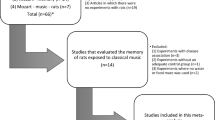Conclusions
Possibilities of checking the model
From the positions of the present study, the principal functions of the HC are the selective singling out or suppression of specific complexes of stimuli (apparently, somehow or other representing the animal's position in the surrounding space [7]) on the basis of the mechanism of “working” memory which, depending upon the conditions of functioning, provides for multidirectional changes in the efficiency of the hippocampal associations.
Several avenues for the experimental checking of the correctness of the principal assumptions of the model may be noted.
-
1.
From the results of the study it follows that the duration of the changes in the probability of a choice in a maze (see Pt. I, 6, 12, 13) depends on the duration of the changes in the efficiency of the associations of the HC (after potentiation and depression). This claim may be checked by comparing the constant times of the return of the corresponding values (the probability of choice and the efficiency of the associations) to the initial level.
-
2.
It follows from the principal claims of the study that with near-threshold (for the obtaining of potentiation) stimulation of the cortical input, the HC may elicit post-activational changes which are opposite by sign, i.e., the potentiation or depression of responses, depending on whether the magnitude of the RF input at the time of the stimulation is at a higher or lower level.
-
3.
From the results of the study it also follows that the probability of a choice in a maze in the next trial of the same branch which was chosen in a preceding trial depends on the frequency of the theta rhythm at the time of the preceding trial. An increase in the probability should be expected if the stay in the given branch in the preceding trial was accompanied by high frequency theta rhythm, and a decrease in the probability should be expected at a low frequency of theta rhythm and with non-regular activity.
Similar content being viewed by others
Literature cited
R. Atkinson, G. Bauers, and E. Crothers, Introduction to Mathematical Learning Theory, Krieger, New York (1965).
O. S. Vinogradova, “The processing of information by the neurons of the hippocampus and by the structures associated with it,” Abstract of Dissertation for the Degree of Doctor of Biological Sciences, Erevan (1983).
O. S. Vinogradova, “Contemporary concepts regarding the general properties and plastic phenomena in neurons of the hippocampus,” Usp. Fiziol. Nauk,15, 1, 28 (1984).
L. L. Voronin, Analysis of the Plastic Properties of the Central Nervous System [in Russian], Metsniereba, Tbilisi (1982).
B. I. Kotlyar, O. B. Zubova and N. O. Timofeeva, “The electrophysiological correlates of behavioral reactions,” Nauchn. Dokl. Vyssh. Shk. Biol. Nauki, 11, 38 (1969).
P. V. Simonov, The Emotional Brain [in Russian], Nauka, Moscow (1981).
J. O'Keefe, “A review of the hippocampal place cells,” Progr. Neurobiol.,13, 419 (1979).
J. B. Ranck, “Behavioral correlates and firing repertoires of neurons in the dorsal hippocampal formation and septum of unrestrained rats,” in: The Hippocampus, Plenum Press, New York (1975), p. 207.
N. A. Schmajuk, “Psychological theories of hippocampal function,” Physiol. Psychol.,12, 3, 166 (1984).
Author information
Authors and Affiliations
Additional information
Translated from Zhurnal Vysshei Nervnoi Deyatel'nosti imeni I. P. Pavlova, Vol. 37, No. 5, pp. 880–887, September–October, 1987.
Rights and permissions
About this article
Cite this article
Maiorov, V.I. Analysis of participation of the hippocampus in organization of behavior in animals. Neurosci Behav Physiol 18, 412–419 (1988). https://doi.org/10.1007/BF01193888
Received:
Issue Date:
DOI: https://doi.org/10.1007/BF01193888




